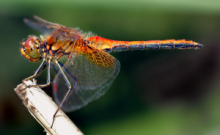Article
Because of their beauty and mobility, dragonflies have earned a special place in various cultures around the world. Although European cultures have tended to associate dragonflies with evil and darkness, many indigenous cultures throughout Asia and the Americas associate the dragonfly with good work habits, happiness, good fortune, and, of course, the essence of life itself, water.
The dragonfly is a large predatory insect generally found around watery areas. The dragonfly can be found hovering near lakes and swamps as the dragonfly larvae (the nymph/baby) is aquatic. The dragonfly nymph is capable of producing a painful bite for humans, where the adult dragonfly poses no threat.
The dragonfly is best known for its beautiful colors and the way its body and wings sparkle when the dragonfly is flying around the water. Dragonflies have long, thin, and generally colorful bodies. They have large eyes and two pairs of transparent wings. As with other species of insects, the dragonfly has three body parts (the head, thorax, and abdomen) and six legs, but it is unable to walk on solid ground. In flight, however, the adult dragonfly can propel itself in six directions which are upward, downward, forward, back, and side to side.
André Karwath aka. A photo created in July 13, 2005.
Manuscripts
References
Corbet, Phillip S.
1999 Dragonflies: Behavior and Ecology of Odonata. Ithaca: Cornell University Press.
Dunkle, Sidney W.
2000 Dragonflies Through Binoculars: a Field Guide to the Dragonflies of North America. New York: Oxford University Press.
Hand, Wayland D.
1973 From Idea to Word: Folk Beliefs and Customs Underlying Folk Speech. American Speech 48(1/2): 67–76.

